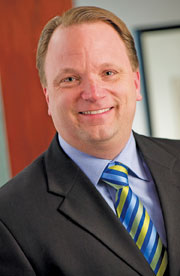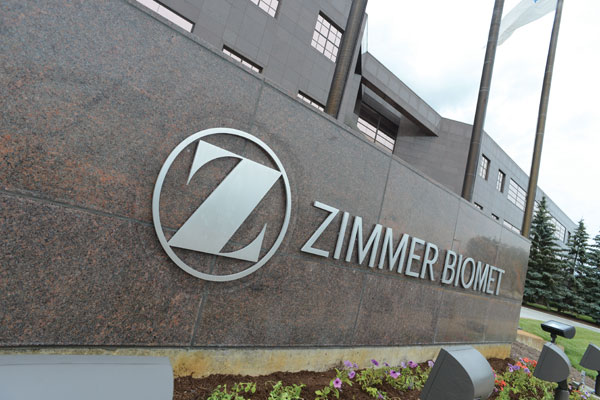What happens when two multibillion-dollar orthopedic implant companies based in the same small Indiana town decide to merge?
Here we explore that topic and more with senior global real estate leaders at newly renamed Zimmer Biomet — still headquartered in Warsaw, Ind., and still stretching around the world with a portfolio that includes everything from huge manufacturing facilities to airplane hangars and hotels.
Below is an excerpt of our Q&A with John Martin, global real estate manager and senior leader of the firm’s global real estate team, and Andrew Urban, international real estate associate manager. Their team oversees more than 400 properties (evenly split between the US and abroad) comprising 8.5 million sq. ft. (789,650 sq. m.) and representing $55 million in annual real estate spend. For the full Q&A, read the November 2015 edition of The Site Selection Life Sciences Report e-newsletter, found at www.siteselection.com.
Site Selection: Walk us through your personal and professional experience of the integration tasks related to the Zimmer Biomet merger.
John Martin: I don’t know if there is a way to easily describe a process like a $13-billion merger, but very early on in the planning process our team was tapped to play an integral role in the real estate planning for the combined company. The executive teams of both companies had a clear vision and deployed a very structured process to tackle the integration planning that assigned a person from each functional or business team to lead the planning process and report up through a steering committee. As one of the leaders for the real estate function, and the only corporate real estate resource, I quickly pulled Andrew and our global service provider into key planning meetings to address the needs of the combined companies. The integration planning process has been one of the most professionally challenging yet rewarding experiences I’ve ever had, and it really has been a privilege to see how the companies have come together.
Andrew Urban: For me personally, it was really an exciting opportunity to work so intimately on shaping the future footprint of the combined company. Like John said, our team was quickly pulled into the integration planning process, and we quickly realized that there was a large task ahead of us, especially considering we were doubling our portfolio size. However, we had already completed a portfolio rationalization 18 months prior, and had spent a considerable amount of time enhancing our processes, so we were well prepared to tackle the task.

SS: How does the history and rivalry of your companies in Warsaw, Ind., affect your work, in terms of corporate culture differences and practical execution?
JM: There certainly was a cordial but competitive atmosphere between the two companies prior to the merger. In addition, both companies had very different cultures with different corporate “language,” so initially there was some learning that both companies had to do. For example, Zimmer had a centralized corporate real estate function for many years, while Biomet had no corporate real estate function.
But from the beginning of the integration planning, both CEOs — David Dvorak (Zimmer Inc.) and Jeffrey Binder (Biomet Inc.) — made it very clear that the goal was to combine the best of both companies to shape the culture of the new company Zimmer Biomet.
AU: One thing I picked up on was that as the key members of each function group and business unit met to begin the planning and integration process, the initial apprehensions faded away quite quickly as people realized how much we all had in common.
SS: Describe your approach to post-merger asset disposition.
JM: Two things our team has really worked hard on are to define a “team operating playbook” that clearly defines our processes in both domestic and international markets by benchmarking global service providers, and to publish a corporate policy that establishes our team as the leader for all real estate transactions. These actions were to ensure that we had buy-in from all our senior management, a set of tools to deliver consistent service to our customers, and best practices to deploy across the company. By putting ourselves in the driver’s seat for all real estate transactions, we are better able to enhance the disposal process by bringing consistent, cost-effective and effective solutions to our key stakeholders.
AU: The reason I really started compiling the playbook was because I was given responsibility for all the international multi-market transactions and needed a reference guide for the different market nuances. Additionally, I discovered that we all were giving similar presentations multiple times to different groups of executive stakeholders and thought it would be beneficial to our entire team to have a consistent format to draw upon. The value in the playbook is that it provides our team easy access to the insights, knowledge, process and resources that we can quickly deploy to our internal customers.
SS: How has the merger changed how you go about your daily business?
JM: I don’t think the merger
has necessarily changed my team’s philosophy or perspective — if anything, it has been reinforced through the integration. The two things I stress to our team are that we need to provide world-class service and deliver optimal cost-effective outcomes to our business partners every day. This philosophy becomes even more important as we handle both business-critical and sensitive projects that are tied to the financial targets of the merger as well as the future viability of the business. Finally, with a merger of this size it is a multi-year
process, and in order to stay informed of changes in strategy we’ve committed ourselves to regular meetings with all of our key executive stakeholders.
AU: Additionally, I think it has really forced our team to go back out and really “sell” our team’s services to leaders that we had never met or who had never even heard about us before as a resource that was at their disposal. The Biomet business did not have a centralized real estate team that focused strictly on transactions and real estate strategy, but once they discovered our expertise, scope of services, and our global integrated service platform, they quickly started utilizing our team as a key resource.
SS: What sort of economic
development measures and policies have you discovered abroad that you look to
as models? What sort of models and practices from the US do you wish you could
replicate at sites abroad?
AU: In my experience both
internationally and domestically there really isn’t a dramatic difference. The
one key is that often international entities and their various layers are
better aligned on requirements and compliance for the incentives which helps
streamline the process for us. One thing I wish was more prevalent domestically
was a streamlined award and approval process among state, county, and city
entities.
SS: What’s your strategy for deploying service providers domestically, and abroad?
JM: Long before the merger we determined that having a scalable team that utilized internal and external resources needed to be a priority. So we developed what we call the “Global Integrated Service Platform” by working with our service provider Summit Realty Group, based in Indianapolis, and customizing a platform of corporate real estate services (brokerage, project management, portfolio strategy, and lease administration) that we can flex to our specific business needs. Their intimate knowledge of the history of our business, plus the commercial real estate talent they were able to bring to us, made them a great extension of our team. In my opinion, the time to build a scalable platform is before a disruptive event like a merger. As internal service providers we need to anticipate the future needs of our senior management customers and address the changing demands of the business.
AU: Another piece of our platform is our incentives advisory firm Ginovus, also based in Indianapolis. The merger presented multiple opportunities for our company to utilize economic incentives to help offset some of our large-scale project costs. However, due to the size of our company we did not have a resource internally that focused strictly on the incentives procurement and compliance. They’ve been able to steer us in the right direction by providing valuable insights into the process, leverage their experience with other large companies, and help us maintain compliance long after the agreement is finalized. Their expertise really showed as we made some large headquarters relocation decisions domestically, and were able to really understand our options from an incentives standpoint.
SS: How do you balance the use of databases and software with the need
for face-to-face visits with the people and places in your portfolio?
JM: We rely heavily on both, I think it is imperative to have accurate data at your disposal to provide the quantitative insights that senior business leaders expect today. Nonetheless, in order to bring those data-driven insights you need to have an intimate understanding of the site, and the only way to do that is to visit. Very often a spreadsheet or database can miss a fundamental flaw in a strategy that an onsite visit would easily detect. Naturally, the merger presented a great opportunity for our team to prioritize site travel from a data collection standpoint, but also a customer service standpoint. Having that direct local knowledge gives us credibility with our local stakeholders and builds relationships to foster collaboration in the future.
AU: Coming from a corporate finance and economics background, I was very keen on deploying metrics that we could use to guide our conversations with senior leadership. However, as our portfolio grew and as the business began to heavily utilize our group, we quickly realized that we need to have a team focus on lease administration tasks. Outsourcing lease administration to Summit Realty Group as part of the global integrated service platform allows me to focus on analyzing and using the data in the portfolio versus inputting the data.

“In my opinion, the time to build a scalable platform is before a disruptive event like a merger.”
SS: Some medical device company leaders have told us that the medical device excise tax that is part of the Affordable Care Act has caused them to delay or cancel plans to invest in new facilities and create more jobs in the US. How has it affected Zimmer Biomet thus far?
JM: The medical device tax without a doubt has affected our business and has really forced us to examine our footprint, and recalibrate future plans. Furthermore, it has really forced our company to examine alternate locations to help us make up the difference to maintain the value to our shareholders in a highly competitive market.
SS: As you emerge from the merger process, how are you strategizing and mapping out the company’s next-generation geography for orthopedic production and R&D?
JM: My role as the senior global real estate leader is to work with the key executives and start having the conversations now to begin to understand their business’s unique needs today and into the future. This is something post-merger we are making a bigger priority — to have those collaborative discussions between the functional stakeholders and align on what some of the future strategies might be.
AU: One thing I have done to support John in his conversations is to continually keep myself educated by researching the latest trends and opportunities in site selection. Reading the latest research from various firms, speaking with experts, networking with other end-users and reading publications like Site Selection magazine provide us insights into potential new opportunities on a regular basis.

